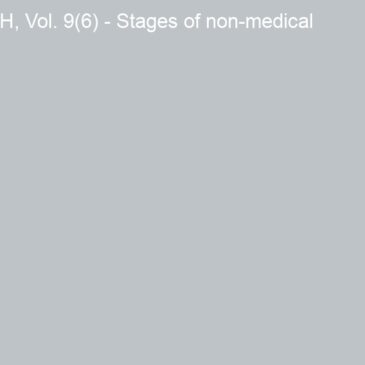Non-medical prescription opioid use (i.e., use of prescription opioid painkillers without a valid medical reason or prescription) is a public health concern in the United States, in part because it is linked with anxiety, depression, and other harmful consequences (Becker, Sullivan, Tetrault, Desai, Fiellin, 2008). Both anxiety and depression are associated with increased risk of suicide (Goldney, Wilson, Dal Grande, Fisher, McFarlane, 2000), and there is some indication that non-medical prescription opioid use is associated with increased risk for suicidal behavior. This week’s STASH reviews a study that adds to our understanding of opioid misuse and suicide by exploring whether people in various stages of non-medical opioid use (e.g., persistent use versus recent-onset use) have different risk of suicidal ideation or attempt (Kuramoto, Chilcoat, Ko, Martins, 2012).
Methods
- This study used data collected as part of the 2009 National Survey on Drug Use and Health (NSDUH; United States Department of Health and Human Services, 2009).
- The NSDUH includes questions that assess past-year suicidal ideation, suicide attempt, and non-medical prescription opioid use.
- The sample consisted of the 37,933 participants who completed the survey aged 18 or older.
- Researchers separated users into four categories in terms of their non-medical prescription opioid use history.
- Persistent users initiated non-medical use more than two years ago and used within the past year.
- Former users initiated non-medical use more than two years ago but did not use within the past year.
- Recent-onset users initiated non-medical use within the last two years regardless of past-year use.
- Non-users did not report any non-medical prescription opioid use.
- Researchers used multiple regressions to determine whether former users, persistent users, or recent onset users were at greater risk for suicidal ideation or suicide attempts compared to non-users.
- Researchers controlled for demographics, other drug use history, and history of major depressive episodes.
Results
- Within the sample, 15% reported using non-medical prescription opioid drugs during their lifetime. Five percent reported past-year use.
- Both former users and persistent users were at significantly elevated risk of past-year suicidal ideation than non-users. Recent onset users were at elevated risk, but the difference was not statistically significant. See Table 1.
- No groups had significantly elevated risk for suicide attempts.
|
|
Non-users
(n = 30,465; 80.3%) |
Former Users
(n = 3,769; 9%) |
Persistent Users
(n = 2,031; 4%) |
Recent Onset Users
(n = 1,668; 2%) |
|
Suicidal Ideation |
N/A
(Comparison group) |
1.42*
[1.11, 1.81] |
1.52*
[1.10, 2.10] |
1.27
[0.94, 1.73] |
| Suicide Attempt | N/A
(Comparison group) |
0.78
[0.41, 1.49] |
1.73
[0.97, 3.09] |
1.52 [0.78, 2.96] |
Figure. Adjusted odds ratios and 95% confidence intervals for the four groups on suicidal ideation. * indicates p < .05. Numbers indicate odds ratios after correcting for demographics, other drug use, and major depressive episode. For example, we can conclude that persistent users were one and a half times more likely than non-users to report suicidal ideation, as the odds ratio is 1.52.
Limitations
- The study relies entirely on self-report data.
- The NSDUH is cross-sectional by nature. This limits our ability to draw conclusions on causality. It also prevents us from drawing conclusions on the time course of this relationship.
- The survey did not collect data on the frequency and dose of opioid use, nor did it allow participants to indicate why they were using the medication. This precludes controlling for factors like chronic pain, which can also influence suicidal ideation.
Conclusions
According to this study, both former and persistent non-medical prescription opioid users show elevated experiences of suicidal ideation, but not suicide attempts. For people who misuse prescription opioids and think about suicide, other factors like chronic pain and depression might play important roles. For example, in one person, chronic pain might cause both depression and opioid use, and depression might cause suicidal thoughts. In another person, depression might cause thoughts about suicide and attempts to self-medicate psychological pain through opioid use. Many different causal chains are possible, and each might require a different kind of treatment plan. This study suggests that clinicians and others who come into regular contact with people who misuse prescription painkillers should provide continued mental health monitoring and support is important, even if a person stops using the opioids.
– Daniel Tao
What do you think? Please use the comment link below to provide feedback on this article.
References
Becker, W.C., Sullivan, L.E., Tetrault, J.M., Desai, R.A., Fiellin, D.A. (2008). Non-medical use, abuse, and dependence on prescription opioids among U.S. adults: Psychiatric, medical, and substance use correlates. Drug and Alcohol Dependence, 94, 38-47.
Goldney, R.D., Wilson, D., Dal Grande, E., Fisher, L.J., McFarlane, A.C. (2000). Suicidal ideation in a random community sample: Attributable risk due to depression and psychosocial and traumatic events. Australian and New Zealand Journal of Psychiatry, 34, 98-106.
Kuramoto, S.J., Chilcoat, H.D., Ko, J., Martins S.S. (2012). Suicidal ideation and suicide attempt across stages of nonmedical prescription opioid use and presence of prescription opioid disorders among U.S. adults. Journal of Studies on Alcohol and Drugs, 73, 178-184.
United States Department of Health and Human Services. Substance Abuse and Mental Health Services Administration. Office of Applied Studies. National Survey on Drug Use and Health, 2009. ICPSR29621-v3. Ann Arbor, MI: Inter-university Consortium for Political and Social Research [distributor], 2012-11-16. doi:10.3886/ICPSR29621.v3




